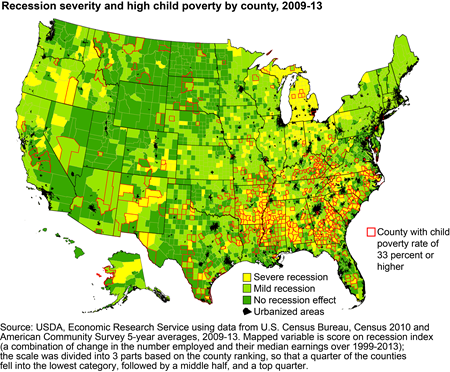Rural Child Poverty Chart Gallery
Note: Updates to this data product are discontinued. Over 1 in 4 rural children are living in families that are poor, according to the official poverty measure, up from 1 in 5 in 1999, but this change was uneven across the rural landscape. Counties with high vulnerability to child poverty, those with both low young adult education levels and high proportions of children in single-parent families, were generally the most hard-hit by the recession of the past decade and experienced substantial increases in their already high child poverty rates. Along with the recession, an increase in rural children in single-parent households, continuing from the 1990s, was a major contributor to the rise in child poverty after 2000. Three factors that shape the geography of high and increasing rural child poverty are explored below: economic conditions, young adult education levels, and family structure. This collection of maps complements the July 2015 Amber Waves feature, Understanding the Geography of Growth in Rural Child Poverty.

The first factor, the economic conditions of the period, was most marked by the severe recession of 2007-09, but involved highly uneven impacts across rural areas and over time. After booming in the 1990s, rural manufacturing jobs began to disappear at the beginning of the 2000s, a trend that accelerated with the recession. While many local economies dependent on manufacturing had severe setbacks, other rural areas experienced booms in oil and gas mining and never felt the recession.?In general, rural counties with severe recession had much higher average child poverty rates in 2009-13 (31 percent) than they had in 1999 (22 percent). Counties largely immune from the recession, with growth in both employment and earnings, did not, however, have a corresponding decline in child poverty, which remained at 20 percent for the period. These?results are similar to the results for the generally prosperous farm and mining counties in suggesting that economic growth itself was largely unable to reduce child poverty over the past decade.

